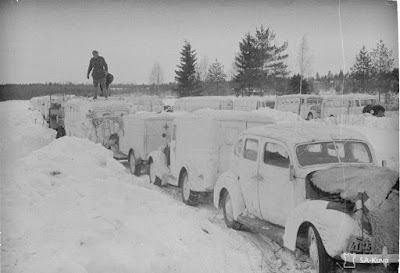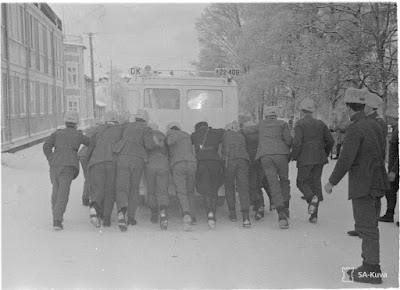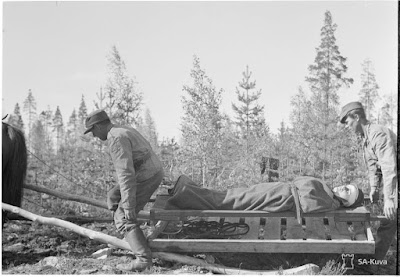Locomotive coffin transport
Finland in the Second World War, winter war, continue war, and Lapland War 1939-1945 are reason to the deceased hero sought to bury their hometowns
hero-grave.
If the fallen in the war could not be recovered front and therefore not possible to calculate a hero graves, they were blessed, and stay to fronts.
The key brings they home are second army corps headquarters Pastor John Sillanpää who founded in Winter War and gather they first evacuation center.
Officially, before the war was the Staff of the order to bury the fallen in the field, such as commonly used in the world.
Immediately after the collapse of the USSR in the early 1990s these opened up the opportunity search the deceased Continuation War, a war zone, mainly in the Karelian Isthmus
---------------
Suomen osalta toisen maailmansodan eli talvi-, jatko- ja Lapin sodan 1939–1945 vuoksi menehtyneet sankarivainajat pyrittiin hautaamaan kotipaikkakuntiensa sankarihautoihin.
Jos sodassa kaatuneiden jäännöksiä ei saatu talteen rintamalla eikä näin ollen voitu laskea sankarihautoihin, ne siunattiin rintamalle jääneinä. Heti Neuvostoliiton hajoamisen jälkeen 1990-luvun alussa avautui mahdollisuus etsiä vainajien jäännöksiä jatkosodan sotatoimialueelta, lähinnä Karjalankannakselta
Avainasemassa kaatuneitten kotiin tuomiseen oli toisen armeijakunnan esikunnan pastori Johannes Sillanpää joka perusti talvisodassa ensimmäisen kaatuneiden evakuointikeskuksen. Virallisesti ennen sotaa esikunnasta oli määräys haudata kaatuneet kentälle kuten yleisesti maailmalla oli tapana.
hospital train locomotive
Swedish voluntary ambulance
field hospital
wounded transmission under cannon fire to horse sleigh
Wounded transport bus is in the ditch (9.12.1939)
Finnish ambulance
Swedish Red Cross cars
The French Red Cross ambulances 3. january 1940
hospital train
Ambulances waiting for the end of the winter war period (09.03.1940)
Frozen Danish ambulance, pushed to engine starts
wounded in bombing victim, the last days of the Winter War
wounded in bombing victim
winter pictures 1940
winter pictures
winter pictures
train hospital nurses in 1939.30.11
hospital train
Wounded in the heat bag
Swedish winter war wounded
-------------------
wounded man (long patrol) retrieved and brought to frontline guard-base
09.07.1941 air bombing - civilian wounded
16.07.1941 air bombing wigtims, civilian wounded loading hospital train
16.07.1942.
08.07.1941 summer and cross-country transport travois, Ilomantsi area
10.07.1941 summer and off-road transport sleigh, Korpiselkä plog
wounded soviet surrender, they become with own horse, to Finnish field hospital
Sick Transport Aircraft difficult to retrieve the wounded Repola's east side, and bring patrol men back to home.
Tolvajärvi tourist hut. German ambulance in the yard.
--------------
Tolvajärven matkailumaja. Saksalainen ambulanssi pihassa.
hospital train kitchen
30.08.1941 - bicycle ambulance
Tilda, the captured a Russian ambulance, nickname "Tiltu"
Sick Transport Aircraft difficult to retrieve the wounded Repola's east side, and bring them to Paltaselkä on the beach between the port, from where they are transported via ambulance Paltamo church village of the Kajaani military hospital.
Paltamo Church Village 1941.08.02
SA-ambulanssi
the fallen evacuation center - all dead bodies neat, washed, and clad
sick train loading
Rukajärvi 09.09.1941
finnish-swedish wounded in the stomach, in sled
wounded in the stomach, in sled, 1942 spring
21.04.1942 Ontosenvaara road.
Football match Officers against of the municipality fathers, for the benefit of invalids
"Already it is time to get injured or fall ills". Ambulance car is outfitted with complete. 20.06.1943 karelian Isthmus, midsummer festival time
Jalkapallo-ottelu upseerit-kunnan isät invaliidien hyväksi. ""Jo on aika loukkaantua tai muuten sairastua"". Ambulanssiauto oli varustautunut valmiiksi.
Phänomen car (ambulanssi) 10.10.1943
Phänomen ambulance inside
Ex finnish ambulance 29.07.1944
Mekrijärvi area, 9.08.1944
milk jug carts Ambulances
first binding field place
18.10.1944 Rovaniemi, against to germany.
06.11.1944 in Lappland, against to Germany.
1941.07.26. Car is english made ambulance
a motorized of the train wagon - moottoroitu vaunu
14.06.1942 travois, terrain transport the wounded
hospital pier
Sick Transport Aircraft difficult to retrieve the wounded Repola's east side, and bring them to Paltaselkä on the beach between the port, from where they are transported via ambulance Paltamo church village of the Kajaani military hospital.
Paltamo Church Village 1941.08.02 (Tant Junkers, mean Junkers Ju 34)
Sairaskuljetuslentokoneet noutavat vaikeasti haavoittuneet Repolan itäpuolelta ja tuovat ne Paltaselkä rannalla oleva lentosatama, josta ne sairasautolla kuljetetaan Paltamon kirkonkylän kautta Kajaanin sotasairaalaan hoidettaviksi.
Paltamo Church village 1941.08.02
The ambulance car who was driving accidentally soviet side of 08/25/41. carrying two Lottas.
They laying in next two days in the car side,and dense grass rescued persons mentioned, the driver wounded, when finnish troops invaded Portin - hoikka road
Port Slim 1941.08.27
Ambulanssiauto, joka ajoi vahingossa vihollisen puolelle 25.8.41. mukanaan kaksi lottaa. Maattuaan kaksi vuorokautta auton vierellä tiheässä ruohikossa pelastuivat mainitut henkilöt, kuljettaja haavoittuneena joukkojemme vallattua Portinhoikan.
Portinhoikka 1941.08.27
bicycle ambulance
One horse power, train transport systems






































































Some amazing photos there!
VastaaPoistaHi, Rodger
PoistaBicycle-ambulance seem like very effective,
:) but only short trips
Tilda.
PoistaMoscow radio propaganda voice, woman, Tilda name (nickname Tiltu in Finland) and Tilda Talk about Finland almost well,
and are sound every day, in the Winter War, but also especially in the Continuation War period
Sivun ensimmäisenä kuvana on Gi-ruumisvaunun kuva. Ymmärsin että sivun kuvat ovat SA-kuva -plavelusta. En kuitenkaan onnistu sieltä tuota kuvaa löytämään. Kerropa hakusanat, joilla sen löytää.
VastaaPoistaKerroppa puolestasi sinä, miksi haluat sen löytää.
PoistaOlen ottanut itselleni taakaksi SJiF/SVR/VR:n rautatievaunujen historian selvittelyn. Siihen hommaan kuuluu mm. eri vaunutyyppien tunnistus.
PoistaRuumisvaunuista ei hirveästi ole kuvia tyrkyllä, joten jokainen löytynyt kuva on arvokas. Ja tietenkin kuvasta pitää osata kertoa sen lähde. Tämän kuvan kohdalla se ilmeisestikin on SA-kuva, mutta ensin se pitää sieltä löytää.
Noh, harrastuksensa kullakin. Mulla tämä sotateema, jäi päälle jo lapsuudessa, viiskytä luvun lopulta alkaen, aikaisemmin kun oli lähes pelkkää villiä länttä. Ja miesten kahvi-kortti-pöytä sotajutut oli silloin vielä lisäämässä vettä myllyyn.
PoistaMutta mitä kuviin tulee, niin siihen se ensimmäisenä ja selkeänä pätkähti näkyville tuo ylin, ja sit seuraava.
Mutta kuinka ne löytää, niin se onkin sitten jo ihan loogisen epälooginen selitys, ettei kyllä ole tietoo, muta, kun vain kuva kerrallaan etsimällä, ja lisään tähän, että yhtä vaikeaa meille kummallekkin, mutta nimihausta saattaa olla apua, mutkunmutkun näissä pakkaa oleen kans noi vuosiluvutkin mukana.
Joten kaikesta tästä edellisestä johtuen, toivotan onnea etsintääsi, ja kuten Hietanen sanoi, älä menetä toivoasi.